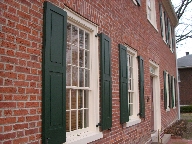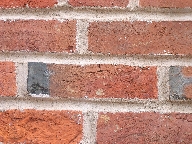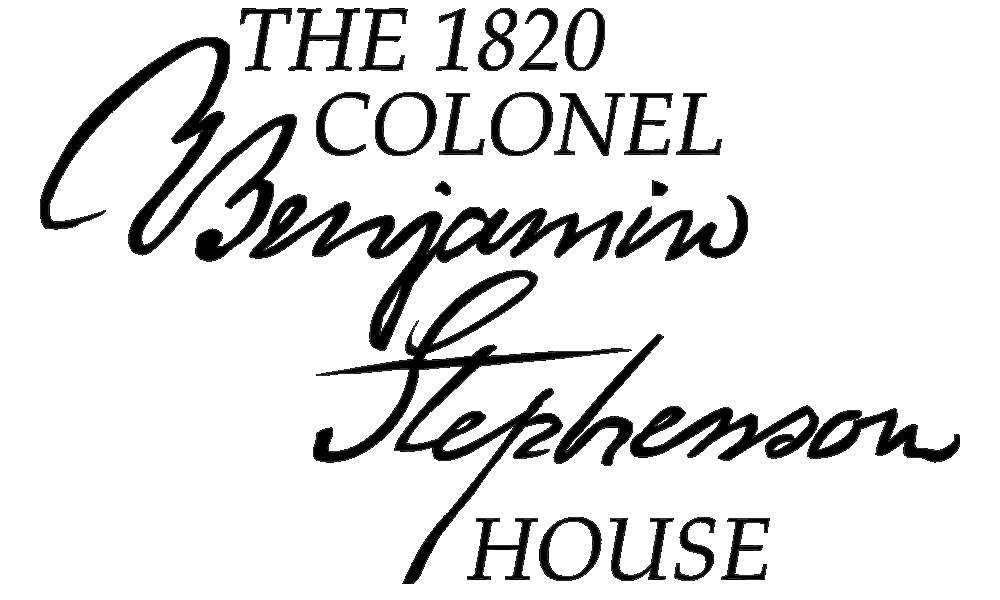The Stephenson House Bricks
 In Colonial America brick was a highly favored building material. In the more settled portions of the colonies, bricks were made by itinerant brick makers who moved from project to project. Even in these areas, the itinerant brick makers tended to function as supervisors while most of the labor was done by local laborers, slaves, or slave children. On the frontier it was probably rare for a professional brick maker to be available. Thus, many bricks were made by local labor and supervised by local individuals. The Stephenson probate records do not reflect any payments to anyone who can be construed as a professional brick maker. It is possible that the manufacture of the bricks was overseen by Colonel Stephenson himself since no one seems to have been paid to do the job. In Colonial America brick was a highly favored building material. In the more settled portions of the colonies, bricks were made by itinerant brick makers who moved from project to project. Even in these areas, the itinerant brick makers tended to function as supervisors while most of the labor was done by local laborers, slaves, or slave children. On the frontier it was probably rare for a professional brick maker to be available. Thus, many bricks were made by local labor and supervised by local individuals. The Stephenson probate records do not reflect any payments to anyone who can be construed as a professional brick maker. It is possible that the manufacture of the bricks was overseen by Colonel Stephenson himself since no one seems to have been paid to do the job.
The process of making bricks was fairly simple though time consuming. Good quality clay free of inclusions was essential. Once the clay was dug it was “puddled.” “Puddling” involved adding water and “treading” the clay. “Treading,” or marching back and forth barefoot on a mixture of clay and water, was a natural job for young workers. “Puddling” was necessary to produce clay of the right consistency: not too dry and not too wet. The puddled clay was rolled in sand and put in molds. The Stephenson probate records reveal that Benjamin Stephenson purchased two and one half sets of brick molds from carpenter Daniel Tolman. Since the term “set” implies more than one, it seems that Stephenson bought at least five molds. The typical mold could make two or more bricks. While early bricks were generally not of standard size, the bricks at the Stephenson house are fairly uniform. They generally measure about 8 ½ inches long, 4 inches wide, and 2 ¼ inches thick.
After the clay was rolled in the sand and thrown into the mold, the excess clay was scraped off of the top. The mold was then turned over in order to remove the bricks from the mold. The wet bricks were allowed to dry on the ground for a short period of time before being moved to a drying shed.
At the Stephenson House, there is a strong likelihood that the puddling of the clay and the molding of the bricks were done by slave children. The use of slaves and slave children in this process was fairly common. Even today children fulfill similar roles in many third world countries.
The probate records reveal the fact that Stephenson paid W.H. Hopkins for 4 ½ days labor for digging clay and also paid Hopkins for eight loads of sand. The total cost of clay and sand was $12.50. Stephenson also had a drying shed built. It was necessary to dry the bricks thoroughly since any moisture left in the brick would turn to steam during firing. The pressure of the expanding steam could cause the brick to explode. The total cost of the drying shed included $3.75 for hauling the material, $9.13 for the purchase of 288 feet of plank, and 50 cents for the purchase of two quarts of whiskey for the laborers who built the shed.
Finally, after the bricks were completely dry, they were fired in a kiln. Mr. Hopkins was paid for “hauling brickbats and cleaning ground for kiln.” Brickbats were broken bricks and were a common material used to construct ovens or kilns. Newly made dried bricks were stacked into the kiln and were fired at high temperatures. Obviously, firing such large quantities of brick required a lot of wood. Hopkins was also paid for ten days hauling wood. At $1.00 a day for cutting, the wood was fairly cheap.
 Professionally made bricks were generally of consistent quality. The Stephenson bricks show significant variation in quality. The major variation is in the quality of firing. The inconsistent firing of the bricks is a major reason for believing that the bricks were not made by professionals. Many of the bricks are very hard indicating that they were fired at high temperatures. Others are very soft, indicating firing at lower temperatures. Additionally, some of the bricks were fired very close to the fire. These bricks are not only very hard, but also are glazed at the end closest to the fire. The glaze is the result of firing temperatures so high that the brick begins to melt. The combination of glazing and ash adhering to the end of the partially melted brick results in a brick with a glassy black end. Only the end closest to the fire exhibits this feature. The end furthest away from the heat source shows the normal brick color. Despite the variations, the quality of the bricks can best be summed up by the fact that the Stephenson House still stands some 189 years after its construction. Professionally made bricks were generally of consistent quality. The Stephenson bricks show significant variation in quality. The major variation is in the quality of firing. The inconsistent firing of the bricks is a major reason for believing that the bricks were not made by professionals. Many of the bricks are very hard indicating that they were fired at high temperatures. Others are very soft, indicating firing at lower temperatures. Additionally, some of the bricks were fired very close to the fire. These bricks are not only very hard, but also are glazed at the end closest to the fire. The glaze is the result of firing temperatures so high that the brick begins to melt. The combination of glazing and ash adhering to the end of the partially melted brick results in a brick with a glassy black end. Only the end closest to the fire exhibits this feature. The end furthest away from the heat source shows the normal brick color. Despite the variations, the quality of the bricks can best be summed up by the fact that the Stephenson House still stands some 189 years after its construction.
Brick making was a major undertaking in the construction of the Stephenson house. Huge quantities of brick were required. Current estimates are that the house construction required almost 95,000 bricks. The additional construction projects of the privy, the barn foundation, the well, and the courtyard and walkways required another
25,000 bricks.
|



